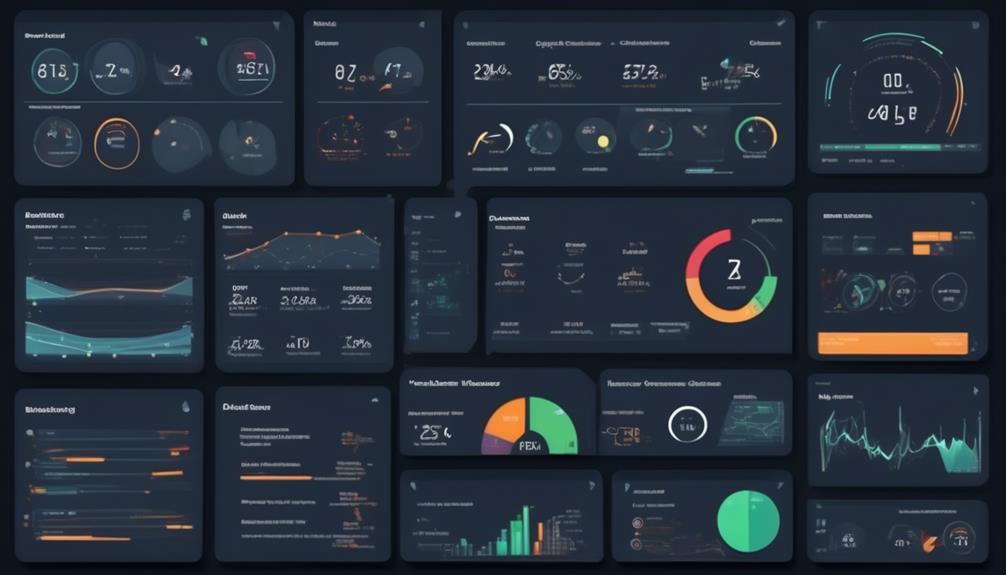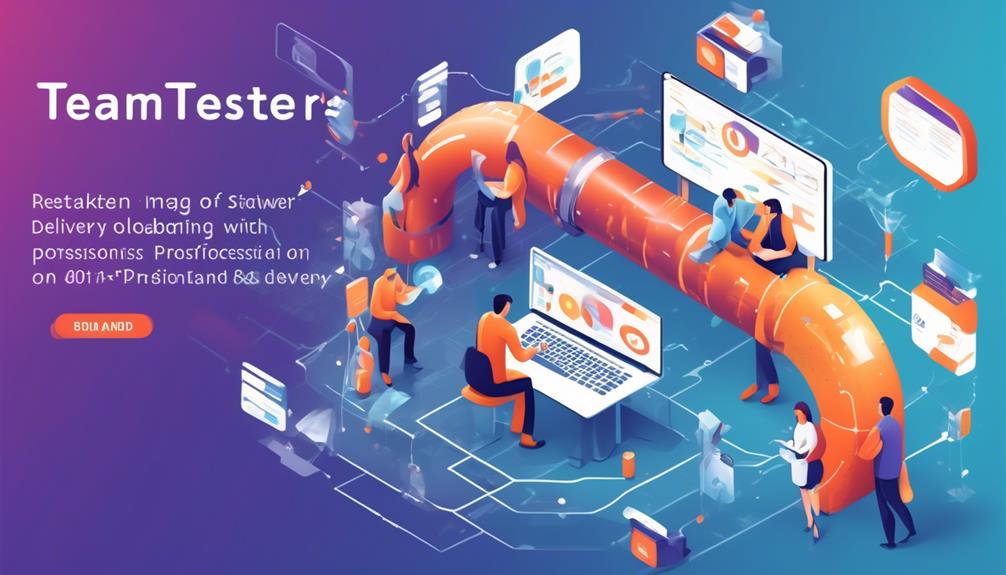In our most recent agile project, we faced significant challenges in maintaining the quality of our product while meeting the demands of a fast-paced development timeline. We found that integrating testing smoothly into our daily development routines was essential for successfully balancing these priorities.
This not only allowed us to identify and address quality issues early on but also fostered a culture of quality within the team. However, this was just the beginning of our journey to ensure quality in agile projects.
There are several other critical strategies and best practices that we needed to implement in order to achieve our goal.
Key Takeaways
- Quality assurance in Agile projects requires a collaborative approach and integration of testing throughout the development process.
- Continuous testing strategies, such as test-driven development (TDD) and behavior-driven development (BDD), are essential for ensuring quality in Agile projects.
- Feedback loops and iterative improvement are crucial in Agile projects, including incorporating feedback from stakeholders and end users, and adapting to changing requirements.
- Cultivating a collaborative culture is important, including open communication, clear communication channels, cross-functional collaboration, and promoting shared understanding and collective ownership.
Quality Assurance in Agile Projects
In agile projects, ensuring quality through thorough testing and continuous feedback is critical to meeting user expectations and maintaining customer satisfaction. Quality assurance in agile projects involves a collaborative approach where the entire team takes responsibility for the quality of the product. In this context, testing isn't a phase that happens at the end of the development cycle but is integrated throughout the product development process. This means that testing occurs continuously, and feedback is provided promptly to the development team for rapid iteration and improvement.
One of the key principles of quality assurance in agile projects is adaptability. The team must be adaptable and responsive to changes, ensuring that the product meets the evolving needs and expectations of the users. Attention to detail is paramount in quality assurance, as even small oversights can have significant impacts on the product. Therefore, the team must maintain a meticulous approach to testing and quality control throughout the agile project.
In agile projects, quality assurance isn't just a function; it's a mindset ingrained in the entire team. It requires a deep understanding of the agile principles and methodologies to effectively integrate quality assurance into the product development process.
Continuous Testing Strategies

Implementing continuous testing strategies in agile projects requires a collaborative approach and a meticulous focus on integrating automated testing, continuous integration, and data analysis to ensure rapid feedback and high-quality product delivery.
To achieve this, the team must embrace practices such as test-driven development (TDD) and behavior-driven development (BDD) to drive quality assurance from the early stages of development.
Additionally, fostering a culture of collaboration and shared responsibility for quality among team members is essential to ensure comprehensive testing coverage.
Utilizing metrics and data analysis to track the effectiveness of testing strategies and identify areas for improvement is crucial in the agile methodology.
Integrating continuous integration and continuous delivery practices streamlines testing and deployment processes, ensuring that quality is maintained throughout the agile process.
By implementing automated testing at every stage of development, the team can ensure quick feedback on quality, enabling them to make necessary adjustments promptly.
These strategies collectively contribute to a high level of quality in agile projects, meeting the demands of a fast-paced development environment.
Feedback Loops and Iterative Improvement
Collaborating closely and maintaining a meticulous focus on feedback loops and iterative improvement allows us to enhance the quality assurance practices initiated in continuous testing strategies within agile projects. In the agile approach, feedback loops are essential for identifying potential issues early on, enabling us to make the necessary adjustments promptly. By actively seeking and incorporating feedback from stakeholders, team members, and end users, we create a culture of constant improvement.
This iterative approach to quality assurance ensures that we're continually refining our processes and delivering high-quality products.
In this environment, feedback loops serve as a mechanism for gathering insights, enabling us to adapt and respond to changing requirements and expectations. By integrating feedback into our development cycles, we foster a collaborative and adaptable atmosphere that's conducive to delivering exceptional results. Through this approach, we not only identify areas for improvement but also capitalize on opportunities for innovation and enhancement.
Embracing feedback loops as a foundational element of our quality assurance practices empowers us to proactively address potential issues and continuously elevate the overall quality of our deliverables within agile projects.
Cultivating Collaborative Culture

Fostering a culture of collaboration and shared responsibility for quality among team members is essential for ensuring the success of agile projects.
To cultivate a collaborative culture within an agile team, we must encourage open communication and transparency to address quality issues promptly.
Establishing clear communication channels and protocols is crucial to prevent misunderstandings and delays, allowing the team to work together seamlessly.
Additionally, promoting cross-functional collaboration is vital to foster shared understanding and collective ownership of the project, aligning with agile principles.
Implementing agile ceremonies, such as sprint planning and daily scrums, ensures effective communication and collaboration, enabling the team to adapt and respond to changes quickly.
Accountability and Ownership
As we move into the topic of 'Accountability and Ownership', it's essential to highlight the key points of team responsibility, individual ownership, and clear roles.
Each team member's commitment to taking ownership of their tasks and the project's overall quality fosters a proactive environment for delivering high-quality products.
Team Responsibility
We take shared responsibility for the success of our project, owning tasks and decisions to ensure high-quality outcomes at every stage of the development process.
In our Agile project, team works together to handle Quality Management, ensuring that each member is committed to delivering high-quality products and is accountable for their contributions.
We encourage a culture of accountability and ownership, allowing members to make independent choices and act in the best interest of the project.
The team collectively takes ownership of the product development process, making quality a priority at every stage.
This fosters a sense of pride and commitment towards delivering quality outcomes, reinforcing our dedication to achieving excellence in our Agile project.
Individual Ownership
Encouraging a culture of individual ownership and accountability fosters a sense of commitment and trust within the team, driving proactive problem-solving and high-quality outcomes. In the agile software development process, each team member takes personal responsibility for the success and quality of the project. This approach promotes self-management and decision-making, empowering individuals to take ownership of their work. It also encourages a sense of ownership and accountability for the tasks assigned to individuals. As a result, a culture of trust and commitment is fostered, with each team member dedicated to delivering high-quality work. This proactive approach to problem-solving and quality improvement is essential for the success of agile projects. Both the product owner and project manager play crucial roles in supporting and reinforcing individual ownership within the team.
| Individual OwnershipAgile Software Development ProcessProduct Owner | ||
|---|---|---|
| Personal responsibility for project success | Promotes self-management and decision-making | Supports and reinforces individual ownership |
| Encourages ownership and accountability | Fosters a culture of trust and commitment | Plays a crucial role in supporting individual ownership |
| Drives proactive problem-solving | Empowers individuals to take ownership | |
| Cultivates high-quality outcomes |
Clear Roles
Transitioning from individual ownership to clear roles within the agile team, we focus on defining and assigning specific responsibilities to ensure accountability and ownership of project activities.
When it comes to quality in agile projects, clear roles play a crucial part in driving success. Here are some key aspects to consider:
- Clearly define and assign roles within the agile team
- Empower team members to take ownership of their responsibilities
- Establish clear accountability for delivering high-quality products
- Encourage a culture of ownership
- Foster an environment where each team member understands their role in building quality while developing the product
Balancing Speed and Quality

To achieve a balance between speed and quality in agile projects, it's essential to prioritize clear communication and continuous feedback loops among team members. By ensuring that everyone understands the user stories and Acceptance Criteria, we can align our efforts towards delivering high-quality work at a sustainable pace.
Agile quality isn't just about meeting the technical specifications; it also involves meeting the needs and expectations of the end users. Therefore, incorporating user acceptance testing (UAT) into our development process allows us to validate that the product not only functions as intended but also provides value to the users.
This iterative approach to testing and feedback enables us to make course corrections early on, preventing quality issues from snowballing and slowing down the project later.
By keeping a close eye on the quality of our deliverables through each sprint, we can maintain a steady cadence while ensuring that we're consistently meeting the required quality standards.
This collaborative approach to balancing speed and quality empowers us to adapt to changes and deliver exceptional results.
Defining and Refining Done Criteria

Let's focus on the essential points of defining and refining 'done' criteria.
Clear acceptance criteria are crucial for ensuring a shared understanding within the team and meeting customer expectations.
Continuous improvement is key, and involving the entire team in this process fosters collaboration, clarity, and accountability.
Clear Acceptance Criteria
We need to define clear acceptance criteria for each user story to ensure a shared understanding of project expectations.
When establishing acceptance criteria, it's crucial to ensure that they're specific, measurable, achievable, relevant, and time-bound (SMART).
Continuous refinement based on feedback and evolving project requirements maintains clarity and relevance.
Collaborating with stakeholders to validate and finalize acceptance criteria promotes transparency and shared ownership of project quality standards.
Regular review and updates of acceptance criteria align with changing project needs and ensure consistent adherence to the Definition of Done.
Continuous Improvement Process
Regularly reviewing and refining the definition of 'done' criteria for user stories and tasks is essential for ensuring continuous improvement in agile projects.
By collecting feedback from stakeholders and team members, we can continuously improve and refine the done criteria, ensuring that they remain relevant and effective.
Implementing automated testing and continuous integration is crucial to consistently meeting the done criteria and avoiding technical debt.
Open communication and transparency are vital for promptly addressing any ambiguity in the done criteria.
Additionally, retrospective meetings provide valuable opportunities to reflect on past iterations, identify areas for refining the done criteria, and enhancing defect identification.
This iterative approach to agile planning fosters a culture of continuous improvement, ultimately leading to higher quality deliverables and increased customer satisfaction.
Team Collaboration for Clarity
To ensure clarity and alignment on quality standards, our team collaborates to establish clear and specific acceptance criteria for user stories, defining when a task is considered completed.
- We regularly refine and update the definition of 'done' to ensure all team members share a common understanding of quality standards.
- Open communication and collaboration are encouraged to clarify and align on the criteria for completed work.
- We foster a culture of shared responsibility for quality by involving the entire team in defining and refining the 'done' criteria.
- Agile ceremonies and meetings are utilized to review and discuss the 'done' criteria, ensuring clarity and alignment within the team.
This collaborative approach, rooted in the principles of the agile manifesto, is essential in project management to uphold quality assurance and deliver exceptional results.
Identifying Defect Patterns

Analyzing historical defect data enables us to identify recurring patterns in software defects, allowing for proactive implementation of preventive measures and continuous improvement in our quality assurance processes.
By looking for commonalities in the types of defects, their root causes, and the areas of the software they occur in, we can categorize and prioritize defect patterns based on their impact on the product and the frequency of occurrence.
This approach empowers us to proactively implement preventive measures and improve the development process. It's crucial to continuously monitor and update the identified defect patterns to ensure ongoing improvement in quality assurance processes.
This iterative analysis not only helps in identifying problems but also in understanding their root causes and devising effective strategies to address them. By leveraging defect patterns, we can ensure quality by addressing issues at their core and preventing their recurrence.
This method not only enhances the quality of the current project but also enriches our knowledge base for future endeavors, making our processes more robust and efficient.
Onboarding New Team Members

Having identified recurring defect patterns and prioritized preventive measures, we now turn our attention to the critical process of onboarding new team members into our agile environment.
Ensuring quality in agile projects requires a seamless integration of new members into the development team, and we've established key strategies for this purpose:
- Establish a clear onboarding process: By outlining a structured onboarding plan, we aim to accelerate the integration of new team members and reduce the time taken for norming and storming phases.
- Educate about company culture and agile methodology: It's crucial to familiarize new hires with our company culture and agile practices to ensure alignment with our values and methodologies from the outset.
- Assign a mentor or support person: Providing guidance and assistance through a dedicated mentor or support person can significantly ease the onboarding process for new team members.
- Utilize resources such as sprint review meeting videos: Access to resources like sprint review meeting videos can help new members quickly grasp ongoing projects and understand their role within the agile framework.
- Encourage open communication and regular check-ins: Open communication and regular check-ins during the onboarding period are essential to guarantee successful integration into our agile team.
Sprint Retrospectives and Feedback Integration

As a team, we regularly conduct sprint retrospectives to reflect on our processes and identify areas for improvement, integrating feedback from stakeholders and end users to enhance the quality of our product.
During these retrospectives, we review our process, including how we manage the product backlog, estimate and track our work using story points, and adapt to changing requirements. By analyzing metrics and data, we can identify trends and make data-driven decisions for continuous quality improvement.
Open and honest communication within the team is crucial during these retrospectives, as it fosters a culture of continuous improvement and encourages everyone to contribute their insights and suggestions for enhancement.
Furthermore, we've implemented a feedback loop with stakeholders to ensure their input is considered and incorporated into the project. This integration of feedback from stakeholders and end users into the development process is essential for enhancing product quality.
Frequently Asked Questions
How Do You Ensure Quality in Agile?
We ensure quality in Agile by continuously collaborating with the team to prioritize and deliver high-quality work.
Our approach involves incorporating regular feedback loops, conducting thorough testing, and adhering to best practices.
By fostering a culture of adaptability and transparency, we maintain a keen focus on meeting customer expectations while upholding high standards for quality.
This allows us to swiftly address any potential issues and deliver value to our clients with each iteration.
How to Measure Quality in Agile?
Measuring quality in Agile involves implementing automated testing and continuous integration for quick feedback. It also involves regularly reviewing and adapting processes. In addition, defining clear quality objectives is important. Using the 3-amigos practice for clear requirements is another key measure. Lastly, fostering a culture of collaboration and shared responsibility is crucial.
Team members work together to ensure these measures are in place and continuously improved to maintain high quality in Agile projects.
How Is Quality Assured in Agile Projects?
Quality assurance in agile projects relies on our team's cohesive effort and relentless pursuit of excellence. We prioritize continuous improvement, customer satisfaction, and early defect identification and resolution.
Testing is seamlessly integrated into our development process, ensuring working software and addressing evolving customer needs. With clear acceptance criteria, regular reviews, and agile metrics, we meticulously track progress.
Our proactive and reactive quality management approaches guarantee that we deliver high-quality products.
What Are Quality Requirements in Agile?
Quality requirements in Agile are established collectively, prioritizing continuous improvement throughout the product development process.
User stories play a crucial role in effectively communicating and understanding quality standards.
We focus on proactive quality management, emphasizing working software.
Metrics like defect density and review effectiveness are used to measure and enhance quality.
Our team is dedicated to maintaining high-quality standards in Agile projects through collaborative efforts and adaptability.
Conclusion
In conclusion, ensuring quality in agile projects requires a proactive and collaborative approach. By integrating testing into everyday development, prioritizing working software, and continuously improving and adapting, we can deliver high-quality, fully functioning software that meets customer expectations.
Through feedback loops, accountability, and a culture of quality, we can identify and prevent defects, cultivate a collaborative culture, and refine our definition of done criteria.
This proactive and detail-oriented approach will help us deliver exceptional products and exceed customer satisfaction.
Randy serves as our Software Quality Assurance Expert, bringing to the table a rich tapestry of industry experiences gathered over 15 years with various renowned tech companies. His deep understanding of the intricate aspects and the evolving challenges in SQA is unparalleled. At EarnQA, Randy’s contributions extend well beyond developing courses; he is a mentor to students and a leader of webinars, sharing valuable insights and hands-on experiences that greatly enhance our educational programs.










